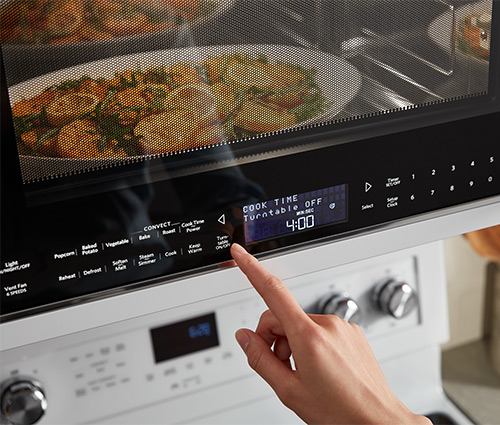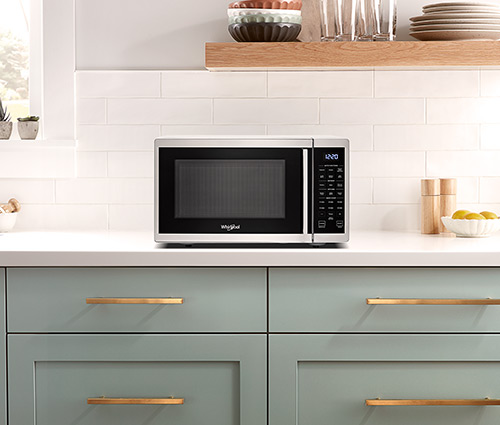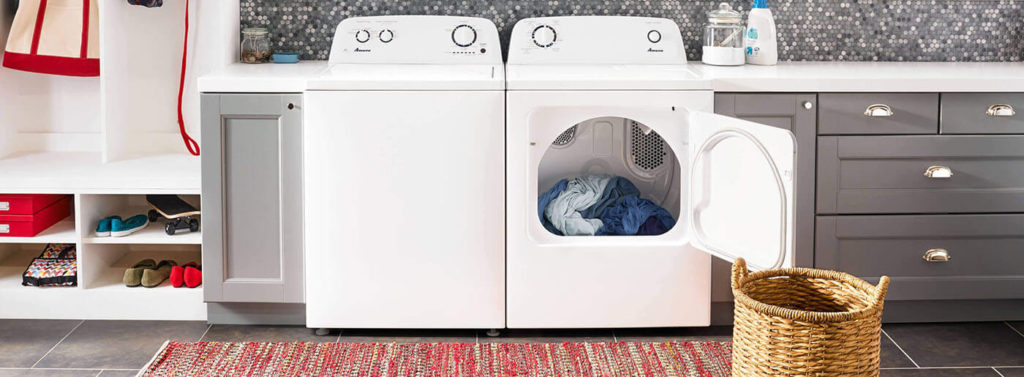Find the Perfect Microwave Size for Your Kitchen
Before you buy a new microwave, you need to research the dimensions and capacities of countertop and over-the-range microwaves to ensure that you get the right fit. Remember, new microwaves offer advanced features and certain models can free up valuable counter space.
Keep reading to learn more about the dimensions, both external and internal, of various microwave types, and then learn how to choose the right microwave.
Standard Microwave Sizes
In figuring out what size of microwave is right for your kitchen, you need to take into account two measurements:
- The external dimensions, measured in inches, are the overall size of the microwave, which determines the amount of space you’ll need for the appliance.
- The internal dimensions–or capacity–are measured in cubic feet (cu. ft.). These dimensions indicate the amount of available space inside the microwave. If you are dealing with a kitchen that has limited space, the depth of the microwave is key in helping you decide what size to buy.
The available microwave styles and microwave dimensions include:
Countertop Microwaves
Countertop microwaves can be placed virtually anywhere in your kitchen or installed in cabinetry with the help of a trim kit.
- Interior space ranges from 0.5 cu. ft. (typically compact microwaves) to over 2.0 cu. ft.
- The exterior width ranges from about 15” or 38 cm for compact microwaves to 24” or 61 cm for larger units.
- Always consider a microwave’s depth with the door open to ensure you have enough space for the full swing-out.
- Closed-door depths range from approximately 14 to 20″ (35.5 to 51 cm).
- Open-door depths range from approximately 27 to 39″ (69 to 99 cm).
Our largest countertop microwave allows you to microwave food in containers of almost any size. Our compact 0.5 cu. ft. microwave is ideal to fit in a corner on most countertops.
Over-The-Range Microwaves
Over-the-range microwaves are a useful and practical way to save counter space, and they can often provide an exhaust for kitchen odours as well.
- Widths will typically be around 30″ (76 cm). This ensures that the microwave will match the standard width of the range underneath and the standard cabinet width where you intend to mount the appliance.
- Interior space typically ranges from 0.8 cu. ft. for compact microwaves to 2.1 cu. ft. for full-sized models. The industry-first Low Profile Microwave Hood Combination by Whirlpool offers the best of both worlds with a design that doesn’t take up a lot of space and 1.1 cu. ft. of interior space to fit wide plates, tall glasses and big bowls.
- Most over-the-range microwaves are approximately 17″ (43 cm) tall.
- The standard width of over-the-range microwaves ensures that the swing-out radius for all models is similar. Closed-door depths typically range from 15 to 18″ (38 to 46 cm) and open-door depths range from 42 to 45″ (107 to 114 cm). You should expect over-the-range microwaves to extend beyond the surface of your cabinets. If you want to achieve a completely flush fit, consider exploring built-in microwaves as these models are designed to be installed directly into existing cabinetry.

Built-in Microwaves
Built-in microwaves offer no venting capabilities and differ from over-the-range microwaves since they are flush with cabinetry on all sides.
- Interior space is typically 1.0 to over 2.0 cu. ft., with 1.2 to 1.6 cu. ft. being the most common range.
- Widths are roughly 24″ (61 cm), 27″ (68.5 cm) or 30″ (76 cm) to align with standard cabinet widths.
- Depths typically range from 30 to 35″ (76 to 89 cm) with the door open and 20 to 25″ (51 to 63.5 cm) with the door closed.
Built-in microwaves often feature a drop-down door and can be installed under the counter or in a cabinet.
How to Measure Your Current Microwave Dimensions
You should always refer to your appliance’s installation instructions or product guide. Furthermore, you need to comply with all local codes and ordinances.
Use the following information as a guide for typical microwave dimensions and the clearances they generally require.

Countertop Microwaves
You need to measure the depth, height and width of your current microwave or the space, typically on a countertop or shelf, where you intend to keep it. Remember to account for the 1″ (2.5 cm) of ventilation space that is required between the microwave and the wall behind it and at least 3″ (8 cm) of space from the edge of the counter to the open microwave door so that the appliance doesn’t tip over.
Don’t forget to leave at least 2” (5 cm) between the microwave and the range.
Over-The-Range and Built-in Microwaves
For over-the-range and built-in microwaves, the width, height and depth of your existing microwave enclosure are more important than the dimensions of the actual appliance.
Most importantly, you need to measure the space between the two cabinets.
PRO TIP: Remember that it’s acceptable for over-the-range microwaves to hang below cabinets if you retain 30″ (76 cm) from the bottom of the microwave to the top of the stove.
If you’re installing your new microwave near a left sidewall, confirm that there is a minimum of 6″ (15 cm) of clearance between the wall and the microwave so that the door can open all the way.
Make sure there is enough space for ventilation based on the manufacturer’s instructions.
Lastly, remember that all built-in microwaves need to be professionally installed.
Other Considerations Besides Size
Here are three other considerations you should keep in mind.
Size of Your Household
It’s common for a household of four people or more to need a full-size microwave. They may even go with both a built-in microwave and a countertop microwave to accommodate everyone’s needs.
How You Use Your Microwave
Do you normally use your microwave to heat or reheat items or make the occasional bag of popcorn for movie night? Or do you use it to cook larger dishes like casseroles?
If you’re cooking entire meals in the microwave, it might be wise to purchase a model with advanced features like sensor or convection cooking.
- Sensor Cooking lets you remove the guesswork from cooking with the help of sensors that track the cooking progress of your food and automatically adjust cook times on the fly. Learn more about this feature here: https://youtu.be/1DozvMRqk0U
- Convection Cooking allows you to cook food in the microwave with the same home-cooked results.
The Amount of Power You’ll Need
Simply put, the more wattage, the faster the food will cook. If you tend to cook frozen foods or foods from scratch, you may require a microwave with higher wattage.
Learn More
Now that you understand the different dimensions of microwaves and how to measure the interior and exterior, you can select one that is ideal for your household.





